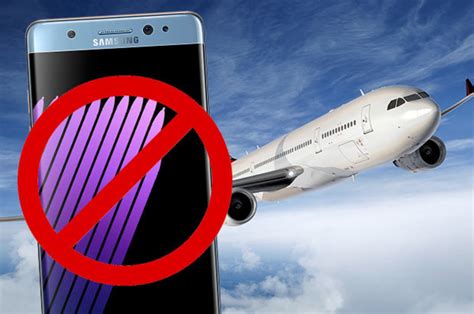
Samsung’s Galaxy Note 7, plagued by battery issues causing overheating and explosions, remains banned from all flights, both domestic and international, according to aviation authorities and airlines worldwide. This prohibition, initially implemented in 2016, continues to be enforced due to the persistent risk the device poses to passenger safety and aircraft integrity.
The ban, affecting both carry-on and checked baggage, underscores the severity of the safety hazard associated with the phone’s defective battery. The U.S. Department of Transportation (DOT), along with the Federal Aviation Administration (FAA), initially issued the emergency order, which remains in effect. This directive extends to all individuals, including passengers and crew members, to prevent potential in-flight incidents.
The Galaxy Note 7 was initially launched in August 2016 but was quickly recalled due to numerous reports of the device’s battery overheating and, in some cases, exploding. Samsung issued two recalls in an attempt to rectify the issue, but the problem persisted even with replacement devices. Ultimately, Samsung discontinued the Galaxy Note 7 in October 2016, urging all consumers to power down and return their devices.
The decision to ban the Galaxy Note 7 from flights was driven by concerns that an overheating or exploding phone could cause a fire, posing a significant threat to the safety of the aircraft and its occupants. Aviation authorities emphasized that even though the phone is no longer widely in use, the ban remains in place as a precautionary measure, ensuring no devices slip through security checks and onto planes.
According to the original FAA statement, “lithium batteries can overheat and cause fires. When this happens in an aviation environment, the results can be catastrophic.” This highlights the seriousness with which aviation authorities view the potential hazards associated with defective lithium batteries.
The ban applies universally across all airlines and jurisdictions, meaning that regardless of where a traveler is flying, carrying a Galaxy Note 7 on board is strictly prohibited. Airlines have been instructed to deny boarding to anyone attempting to bring the device onto a flight, and passengers found with the phone in their possession may face fines and confiscation of the device.
The ongoing ban serves as a reminder of the critical importance of product safety and the potential consequences when products with inherent defects are introduced to the market. The Galaxy Note 7 incident has led to increased scrutiny of lithium-ion batteries used in electronic devices and has prompted calls for more stringent testing and quality control measures.
Background and Context of the Galaxy Note 7 Crisis
The Galaxy Note 7 was initially hailed as a cutting-edge smartphone with advanced features, including a curved display, iris scanner, and improved S Pen functionality. It was intended to compete with other high-end smartphones on the market and solidify Samsung’s position as a leader in the mobile technology industry.
However, shortly after its release, reports began to surface of the phone’s battery overheating and, in some cases, exploding. These incidents raised serious safety concerns and prompted Samsung to launch an investigation into the cause of the problem.
The initial investigation pointed to a manufacturing defect in the batteries produced by one of Samsung’s suppliers. The defect was believed to cause the positive and negative electrodes within the battery to come into contact, leading to a short circuit and subsequent overheating.
In response to the initial reports, Samsung announced a voluntary recall of the Galaxy Note 7 in early September 2016. The company offered to replace the affected devices with new ones that were supposed to have a redesigned battery.
However, even after the replacement program was implemented, reports of overheating and explosions continued to surface. This led to concerns that the issue was more widespread than initially believed and that the replacement devices were also affected.
Following the continued reports of incidents, Samsung announced a second recall of the Galaxy Note 7 in October 2016. This time, the company urged all consumers to power down their devices and return them for a full refund or exchange. Samsung also suspended production of the Galaxy Note 7, effectively discontinuing the product.
The Galaxy Note 7 crisis had a significant impact on Samsung’s reputation and financial performance. The company faced substantial financial losses due to the cost of the recalls, lost sales, and damage to its brand image. The incident also raised questions about Samsung’s quality control processes and its ability to identify and address potential safety issues before releasing products to the market.
Regulatory Actions and Industry Response
The Galaxy Note 7 crisis prompted regulatory agencies around the world to take action to ensure the safety of air travel. The U.S. Department of Transportation (DOT) and the Federal Aviation Administration (FAA) were among the first to issue a ban on the Galaxy Note 7 on flights.
Other countries and airlines followed suit, implementing similar bans to prevent the device from being carried on board aircraft. These bans were put in place to protect passengers and crew members from the potential risk of a fire caused by an overheating or exploding Galaxy Note 7.
The International Air Transport Association (IATA), which represents airlines around the world, also issued guidance to its member airlines regarding the Galaxy Note 7. IATA recommended that airlines inform passengers about the ban and take steps to ensure that the device was not carried on board flights.
The Galaxy Note 7 crisis also led to increased scrutiny of lithium-ion batteries used in electronic devices. Aviation authorities and industry experts called for more stringent testing and quality control measures to prevent similar incidents from happening in the future.
Impact on Passengers and Airlines
The ban on the Galaxy Note 7 had a significant impact on passengers who owned the device. Many travelers were forced to leave their phones at home or find alternative ways to communicate while traveling. The ban also caused inconvenience and frustration for passengers who were unaware of the restrictions and had to deal with the confiscation of their devices at airport security checkpoints.
Airlines also faced challenges in implementing and enforcing the ban. They had to train staff to identify the Galaxy Note 7 and inform passengers about the restrictions. Airlines also had to deal with the potential for confrontation with passengers who refused to comply with the ban.
In some cases, airlines offered passengers incentives to surrender their Galaxy Note 7 devices before boarding flights. These incentives included vouchers, refunds, or free upgrades.
Long-Term Implications and Lessons Learned
The Galaxy Note 7 crisis had several long-term implications for the mobile technology industry and the aviation industry. The incident highlighted the importance of product safety and the potential consequences when products with inherent defects are introduced to the market.
The crisis also led to increased awareness of the risks associated with lithium-ion batteries and the need for more stringent testing and quality control measures. Manufacturers of electronic devices were urged to prioritize safety over innovation and to take steps to ensure that their products are safe for consumers to use.
The Galaxy Note 7 crisis also prompted a review of aviation safety regulations and procedures. Aviation authorities and airlines worked together to develop new protocols for handling electronic devices on board aircraft and to improve the detection of potentially hazardous items.
One of the key lessons learned from the Galaxy Note 7 crisis is the importance of transparency and communication. Samsung was criticized for its initial response to the crisis, which was perceived as slow and inadequate. The company was urged to be more transparent with consumers and to provide timely and accurate information about the risks associated with the Galaxy Note 7.
Another lesson learned is the importance of thorough testing and quality control. Samsung’s quality control processes were found to be inadequate, leading to the release of a product with a critical defect. The company was urged to strengthen its quality control processes and to invest in more rigorous testing procedures to prevent similar incidents from happening in the future.
Technological Advancements and Future Outlook
In the years since the Galaxy Note 7 crisis, there have been significant advancements in battery technology and safety measures. Manufacturers have developed new battery designs and materials that are less prone to overheating and explosion. They have also implemented more sophisticated testing procedures to identify and address potential safety issues.
One of the key areas of focus has been on improving the stability and durability of lithium-ion batteries. Researchers are exploring alternative battery chemistries, such as solid-state batteries, which are considered to be safer and more energy-dense than traditional lithium-ion batteries.
Manufacturers are also implementing more advanced thermal management systems in electronic devices to prevent overheating. These systems use sensors and cooling mechanisms to regulate the temperature of the battery and other components.
In addition to technological advancements, there has also been increased regulatory oversight of battery safety. Government agencies and industry organizations have developed new standards and guidelines for the testing and certification of batteries. These standards are designed to ensure that batteries meet certain safety requirements before they are allowed to be sold to consumers.
While the risk of battery-related incidents has been reduced, it has not been completely eliminated. Consumers are still advised to take precautions when using electronic devices with lithium-ion batteries, such as avoiding extreme temperatures and using only authorized chargers.
Current Status and Enforcement
As of 2024, the ban on the Galaxy Note 7 remains in effect across all major airlines and aviation authorities worldwide. The FAA continues to list the Galaxy Note 7 as a prohibited item on its website, advising passengers not to pack the device in either carry-on or checked baggage.
Airlines continue to train their staff to identify the Galaxy Note 7 and to enforce the ban. Passengers who attempt to bring the device on board a flight may face fines, confiscation of the device, and potential legal consequences.
Despite the fact that the Galaxy Note 7 is no longer widely in use, aviation authorities have maintained the ban as a precautionary measure. They recognize that some devices may still be in circulation and that the risk of a battery-related incident remains a concern.
The ongoing ban serves as a reminder of the importance of product safety and the potential consequences when products with inherent defects are introduced to the market. It also highlights the need for continued vigilance and proactive measures to prevent similar incidents from happening in the future.
The incident spurred a broader discussion about consumer product safety, particularly regarding lithium-ion batteries, prompting stricter regulations and improved testing methodologies. This event underscores the balance between technological innovation and rigorous safety protocols, ultimately shaping how electronic devices are manufactured, tested, and regulated globally.
FAQ: Galaxy Note 7 Flight Ban
-
Why is the Galaxy Note 7 still banned from flights?
The Galaxy Note 7 is still banned from flights due to the risk of its battery overheating and potentially exploding, posing a fire hazard on board aircraft. This ban remains in effect as a precautionary measure, even though the device is no longer widely in use. The U.S. Department of Transportation (DOT) and the Federal Aviation Administration (FAA) continue to enforce this ban to ensure passenger safety. As per the FAA, “lithium batteries can overheat and cause fires. When this happens in an aviation environment, the results can be catastrophic.”
-
What should I do if I still own a Galaxy Note 7?
If you still own a Galaxy Note 7, you should immediately power it down and not attempt to use or charge it. It is recommended to contact Samsung or a local electronics recycling center for proper disposal. Do not attempt to bring it on any flight, as it is prohibited and could result in fines and confiscation.
-
Does the ban apply to all flights worldwide?
Yes, the ban on the Galaxy Note 7 applies to all flights worldwide, including both domestic and international routes. Aviation authorities across the globe have implemented similar restrictions to prevent the device from being carried on board aircraft. It doesn’t matter where you are flying; the Galaxy Note 7 is not permitted on any flight.
-
What are the consequences of attempting to bring a Galaxy Note 7 on a flight?
Attempting to bring a Galaxy Note 7 on a flight can result in severe consequences. Passengers may face fines, confiscation of the device, and potential legal repercussions. Airlines are instructed to deny boarding to anyone attempting to bring the device onto a flight, and passengers found with the phone may face additional penalties.
-
Is Samsung still offering refunds or exchanges for the Galaxy Note 7?
While the official recall and refund program has likely expired, it’s advisable to contact Samsung directly to inquire about potential options. However, it’s important to prioritize the safe disposal of the device. Contacting Samsung’s customer support can provide clarification on any remaining support or options for handling the device.
Expanded Analysis of Battery Technology and Safety
The Galaxy Note 7 debacle brought to the forefront the critical importance of battery technology and safety, particularly in the context of consumer electronics and air travel. Lithium-ion batteries, the power source for most modern smartphones, laptops, and other portable devices, are inherently susceptible to thermal runaway, a process where a battery cell overheats and can potentially ignite or explode. Understanding the intricacies of this technology and the safety measures in place is essential for both consumers and industry professionals.
Lithium-ion batteries consist of several key components: a positive electrode (cathode), a negative electrode (anode), an electrolyte solution that facilitates the movement of lithium ions between the electrodes, and a separator that prevents direct contact between the electrodes, which could cause a short circuit. The electrolyte is typically a flammable organic solvent, adding to the potential fire hazard.
The thermal runaway process is triggered when the battery cell is subjected to conditions that cause it to overheat, such as overcharging, physical damage, or exposure to extreme temperatures. As the temperature increases, the internal chemical reactions accelerate, generating more heat in a positive feedback loop. If the heat generation exceeds the rate at which it can be dissipated, the battery cell can reach a critical temperature, leading to the breakdown of the separator and a short circuit. This can result in the release of flammable gases, ignition, and a violent explosion.
Manufacturers employ several safety measures to mitigate the risk of thermal runaway in lithium-ion batteries. These include:
-
Battery Management Systems (BMS): These systems monitor various parameters of the battery, such as voltage, current, and temperature, and take corrective actions to prevent overcharging, over-discharging, and overheating. BMS can also disconnect the battery from the circuit in case of a fault condition.
-
Circuit Protection Devices: Fuses and other circuit protection devices are used to interrupt the flow of current in case of a short circuit or other electrical fault.
-
Thermal Management Systems: These systems use heat sinks, cooling fans, and other thermal management techniques to dissipate heat and maintain the battery within a safe operating temperature range.
-
Improved Battery Chemistry: Researchers are continuously working on developing new battery chemistries that are more stable and less prone to thermal runaway. Solid-state batteries, which use a solid electrolyte instead of a liquid electrolyte, are considered to be a promising alternative to traditional lithium-ion batteries.
-
Robust Packaging: The battery pack is typically enclosed in a robust housing that is designed to protect the battery cells from physical damage and to contain any potential fire or explosion.
Despite these safety measures, the risk of thermal runaway cannot be completely eliminated. The Galaxy Note 7 incident highlighted the fact that even with sophisticated safety systems in place, manufacturing defects, design flaws, or external factors can still lead to battery failures.
In the wake of the Galaxy Note 7 crisis, there has been increased scrutiny of battery testing and certification procedures. Regulatory agencies and industry organizations have developed more stringent standards for battery safety, requiring manufacturers to conduct rigorous testing to ensure that their batteries meet certain safety requirements. These tests include:
-
Overcharge Test: The battery is subjected to an overcharge condition to assess its ability to withstand excessive voltage.
-
Short Circuit Test: The battery is intentionally short-circuited to evaluate its ability to prevent or contain a thermal runaway event.
-
Thermal Abuse Test: The battery is exposed to high temperatures to determine its thermal stability.
-
Impact Test: The battery is subjected to mechanical impact to assess its resistance to physical damage.
-
Vibration Test: The battery is vibrated to simulate the conditions experienced during transportation and use.
The results of these tests are used to certify that the battery meets the required safety standards. Batteries that pass the certification tests are typically marked with a safety logo or symbol, indicating that they have been tested and approved for use.
The Broader Impact on Consumer Electronics
The Galaxy Note 7 incident had a ripple effect across the consumer electronics industry, prompting manufacturers to re-evaluate their product development and quality control processes. The incident served as a wake-up call, highlighting the potential consequences of prioritizing innovation and time-to-market over safety.
One of the key changes that resulted from the Galaxy Note 7 crisis was an increased emphasis on thorough testing and validation. Manufacturers are now investing more time and resources in testing their products to identify and address potential safety issues before they are released to the market.
Another important change was an increased focus on supply chain management. Samsung’s investigation into the Galaxy Note 7 battery failures revealed that a manufacturing defect in batteries produced by one of its suppliers was a major contributing factor. As a result, manufacturers are now paying closer attention to their suppliers and implementing more stringent quality control measures throughout the supply chain.
The Galaxy Note 7 crisis also led to increased consumer awareness of product safety. Consumers are now more likely to scrutinize product reviews and safety ratings before making a purchase. They are also more likely to report potential safety issues to manufacturers and regulatory agencies.
The incident also underscored the importance of transparency and communication. Samsung was criticized for its initial response to the crisis, which was perceived as slow and inadequate. The company was urged to be more transparent with consumers and to provide timely and accurate information about the risks associated with the Galaxy Note 7.
In the aftermath of the Galaxy Note 7 crisis, Samsung took several steps to regain consumer trust and restore its reputation. These included:
-
Issuing a formal apology to consumers for the Galaxy Note 7 debacle.
-
Conducting a thorough investigation into the cause of the battery failures.
-
Implementing more stringent quality control measures throughout its product development and manufacturing processes.
-
Improving its communication with consumers and regulatory agencies.
-
Investing in new battery technologies that are safer and more reliable.
The Galaxy Note 7 incident serves as a cautionary tale for the consumer electronics industry. It highlights the importance of prioritizing safety over innovation and of investing in robust quality control measures to prevent product defects. It also underscores the need for transparency and communication in the event of a product safety crisis. By learning from the mistakes of the past, manufacturers can build safer and more reliable products that consumers can trust.
Future Trends in Battery Technology
The pursuit of safer, more efficient, and longer-lasting batteries is a driving force behind ongoing research and development in the field of battery technology. Several promising technologies are emerging that could potentially replace or augment traditional lithium-ion batteries in the future.
-
Solid-State Batteries: As mentioned earlier, solid-state batteries use a solid electrolyte instead of a liquid electrolyte. This eliminates the risk of electrolyte leakage and reduces the flammability of the battery. Solid-state batteries also have the potential to offer higher energy density and faster charging times.
-
Lithium-Sulfur Batteries: Lithium-sulfur batteries use sulfur as the cathode material, which is much more abundant and less expensive than the metal oxides used in lithium-ion batteries. Lithium-sulfur batteries also have the potential to offer higher energy density. However, they suffer from poor cycle life and other technical challenges that need to be addressed before they can be commercially viable.
-
Sodium-Ion Batteries: Sodium-ion batteries use sodium instead of lithium as the charge carrier. Sodium is much more abundant and less expensive than lithium, making sodium-ion batteries a potentially attractive alternative to lithium-ion batteries. However, sodium-ion batteries typically have lower energy density than lithium-ion batteries.
-
Magnesium-Ion Batteries: Magnesium-ion batteries use magnesium instead of lithium as the charge carrier. Magnesium is also more abundant and less expensive than lithium. Magnesium-ion batteries have the potential to offer higher energy density and improved safety compared to lithium-ion batteries. However, they are still in the early stages of development.
-
Graphene Batteries: Graphene is a two-dimensional material composed of a single layer of carbon atoms. It has exceptional electrical conductivity and mechanical strength, making it an attractive material for use in batteries. Graphene can be used as an electrode material or as a conductive additive to improve the performance of existing battery chemistries.
These are just a few of the many promising battery technologies that are being developed. It is likely that one or more of these technologies will eventually replace or augment traditional lithium-ion batteries in the future, leading to safer, more efficient, and longer-lasting power sources for consumer electronics, electric vehicles, and other applications.
In conclusion, the Galaxy Note 7 incident remains a significant event in the history of consumer electronics, underscoring the critical importance of product safety, rigorous testing, and transparent communication. The ongoing ban on the device on flights serves as a constant reminder of the potential consequences of neglecting these principles. While advancements in battery technology continue to emerge, the lessons learned from the Galaxy Note 7 crisis will continue to shape the industry’s approach to product development and safety for years to come.









